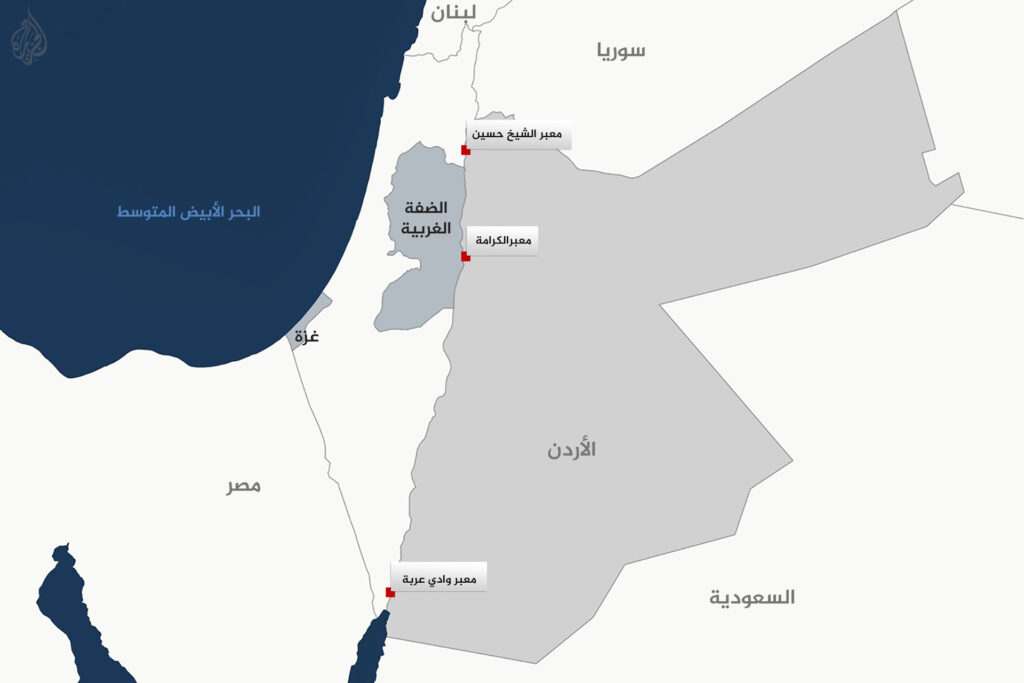Aljazeera.net correspondents
Oman- The shooting operation carried out by Jordanian Maher Al-Jazi two days ago, which led to the killing of 3 Israelis, shed light on the crossings linking Jordan and Palestine, whether the West Bank or the occupied territories.
There are 3 crossings currently in use: Sheikh Hussein, Al-Karamah, and Wadi Araba, while there are also several border bridges that have historically linked the two countries and have undergone changes in terms of use and closure depending on political circumstances and conflict events.
Al-Karamah crossing
It is located near the city of Jericho, and is considered one of the most important bridges extending across the Jordan River. It was built in the late 19th century. The occupation calls it the “Allenby Bridge” in reference to the British General Edmund Allenby, who led his forces to occupy Jerusalem in 1917.
In Jordan, it is known as the “King Hussein Bridge”, and the Palestinians call it the “Karameh Crossing” in honor of the famous Battle of Karameh in 1968, which represented a symbol of Palestinian and Jordanian steadfastness against the Israeli occupation.
Today, the crossing is used to transport people between Jordan and the West Bank and is one of the few crossings open for Palestinians to cross into and out of the Kingdom. It is also used to bring in aid trucks heading to the Gaza Strip.
Sheikh Hussein crossing
Also known as the “Jordan River Crossing” by the occupation, it is located near the city of Beisan and in the town of Shuna al-Shamalia on the Jordanian side. It was built in the late 19th century by Sheikh Hussein al-Shaqran to facilitate the passage of pilgrims from Jenin to Mecca.
The bridge was closed after the 1948 Nakba, then reopened after the Jordanian-Israeli peace agreement in Wadi Araba in 1994, and is currently used to transport people and goods between Jordan and the occupation.
His name was associated with a “land bridge” that was said to be for trucks departing from the Emirates, passing through Saudi Arabia and Jordan, to supply the occupation with goods. It was created after the Houthis announced that they were preventing ships heading to the occupied territories from passing through the Red Sea, while Jordan officially denied its existence.
Wadi Araba crossing
It was opened after the signing of the peace agreement between Jordan and the occupation in 1994 and connects occupied Umm al-Rashrash (Eilat) and Aqaba. The occupation calls it “Yitzhak Rabin” and it is used for Israelis and foreign tourists in transit as well as for transporting cargo trucks.
Strategic axis
The Jordan River, the geographical divider between the Kingdom and occupied Palestine, represents a strategic and historical axis through which several other bridges extend, which were closed at different times. Among them:
Also known as the “Prince Muhammad” Bridge in Jordan and the “Adam Bridge” in the occupation, it is located near the city of Tubas and dates back to the reign of Sultan Al-Zahir Baybars (d. 676 AH/1277 AD) in the Mamluk era. It was used to transport people and goods across the Jordan River.
The bridge was closed after the 1967 war, and was reopened for a short period in 1976, before being closed again at the end of the Al-Aqsa Intifada due to repeated resistance operations in the area, and it has remained closed to this day.
It is located near the confluence of the Yarmouk River with the Jordan River. It was built in a strategic location, and is known to have been closed since 1948. It was given this name because it was the meeting point of many ancient trade routes.
- Jacob’s daughters bridge
It is located between Lake Tiberias and Lake Hula, north of the Jordan River. Its construction dates back to the Ayyubid era. It is believed that its name goes back to the Prophet Jacob, peace be upon him. It was also closed due to the occupation.
These bridges represent ongoing points of tension between the Israeli occupation and the Palestinians and Jordanians, especially with the occupation’s continued policy of imposing restrictions on the movement of Palestinians and preventing them from crossing freely.
Historically, bridges have been vital points of communication for trade, pilgrimage and transportation, making them a constant presence in the arena of resistance to occupation.

